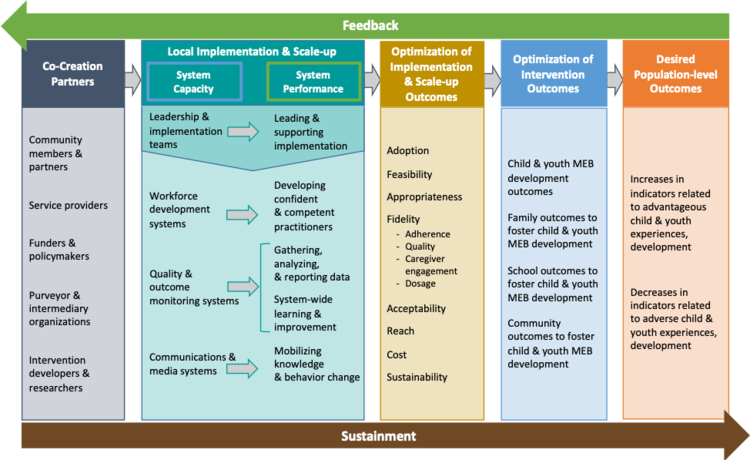Intermediary Organizations: Bridging Implementation Research and Implementation Practice to Achieve Sustainable Outcomes
By Will Aldridge, Director, The Impact Center at FPG & Advanced Implementation Specialist, Renee Boothroyd, Associate Director, The Impact Center at FPG & Advanced Implementation Specialist, Robin Jenkins, Associate Director, The Impact Center at FPG & Advanced Implementation Specialist, and Sandra Diehl, Media & Networking Core Lead, The Impact Center at FPG & Implementation Specialist.
Ramaswamy and colleagues (2019, p. 3) wrote that implementation practice asks the question, “How should [knowledge from implementation research] be adapted and applied in particular practice contexts and settings to achieve sustainable outcomes?” This question has become more familiar and important as implementation science has started to experience its own research-to-practice gap.
The Impact Center at FPG provides support to state and community partners implementing or scaling effective programs, practices, and policies. Our goal is to make implementation science work for their needs, their context, and their outcomes. But making implementation science work in practice settings is tough. It requires perspective and behavior change among diverse stakeholders, as well as organization and system change.
This is possible only if we can make implementation science understandable, practical, and doable in our partners’ settings. Given the proliferation of implementation frameworks, models, and concepts, this can be challenging. To this end, we help our partners find their footing by understanding their roles and activities within a theory of change that (1) leads to the child and family outcomes they are seeking, while (2) integrating essential concepts from implementation science.
A theory of change for implementation supports
Our original theory of change was developed and applied within the Implementation Capacity for Triple P (ICTP) projects (Aldridge, et al., 2016). In ongoing ICTP project efforts, our team works with public-private partnerships at state and community-levels in North Carolina and South Carolina to support scale-up of the Triple P – Positive Parenting Program system of interventions. Chinman and colleagues’ (2016) seminal model informed the development of this theory of change and, notably, it was recently adapted for a National Academies of Science, Engineering, and Medicine consensus study report, Fostering Healthy Mental, Emotional, and Behavioral Development in Children and Youth: A National Agenda (see Figure 1).
Figure 1. Integrated theory of change for the successful, sustainable scale-up of evidence-based interventions. CREDIT: National Academies of Sciences, Engineering, and Medicine. 2019. Fostering Healthy Mental, Emotional, and Behavioral Development in Children and Youth: A National Agenda. https://doi.org/10.17226/25201. Reprinted with permission the National Academy of Sciences, Courtesy of the National Academies Press, Washington, D.C.
Beyond offering a change framework to ground our partners, this theory of change provides a roadmap for our contributions to the change process. As we provide implementation support, our practice behaviors need to contribute to a system’s capacity for effective implementation: organizational infrastructure, resources, and abilities at each level of the system. These capacities are necessary to ensure strong and sustainable system performance and drive good implementation outcomes.
This theory of change has also meant we’ve needed meaningful ways to measure capacity at different levels of the system. For the ICTP projects, we adapted early versions of National Implementation Research Network assessments. The Community Capacity Assessment for the Triple P System of Interventions (CCA-TP) measures community resources and abilities to effectively scale-up Triple P. The Implementation Drivers Assessment for Agencies Implementing Triple P Interventions (IDA-TP) measures organizational infrastructure and best practices to implement Triple P interventions in local service agencies.
These assessments have demonstrated meaningful results that are not only associated with key implementation outcomes like fidelity (Aldridge et al., 2017), but offer concrete information to both our community partners and our support providers for action planning. Together, we hope this Theory of Change and our capacity assessments, along with other information and resources available from The Impact Center at FPG website and the ICTP projects website, help you and your partners think about how to communicate, plan, and measure change in implementation practice.
This article was featured in our monthly Implementation in Action bulletin! Want to receive our next issue? Subscribe here.




